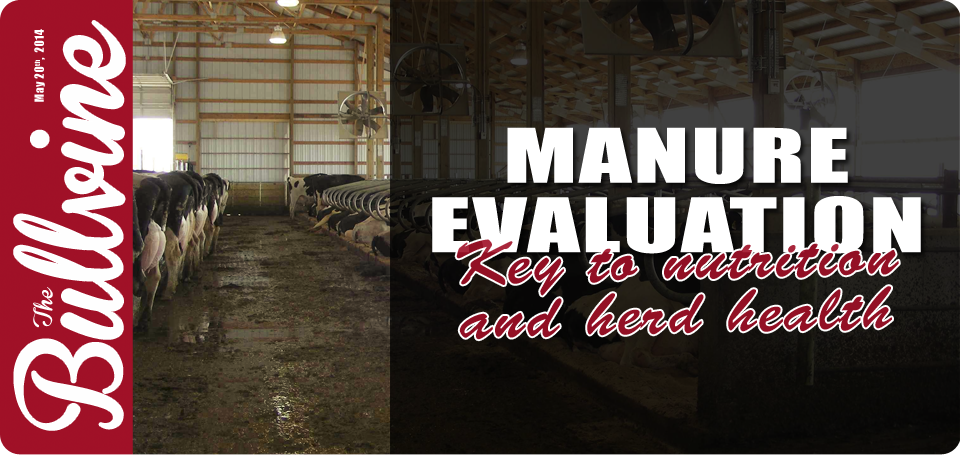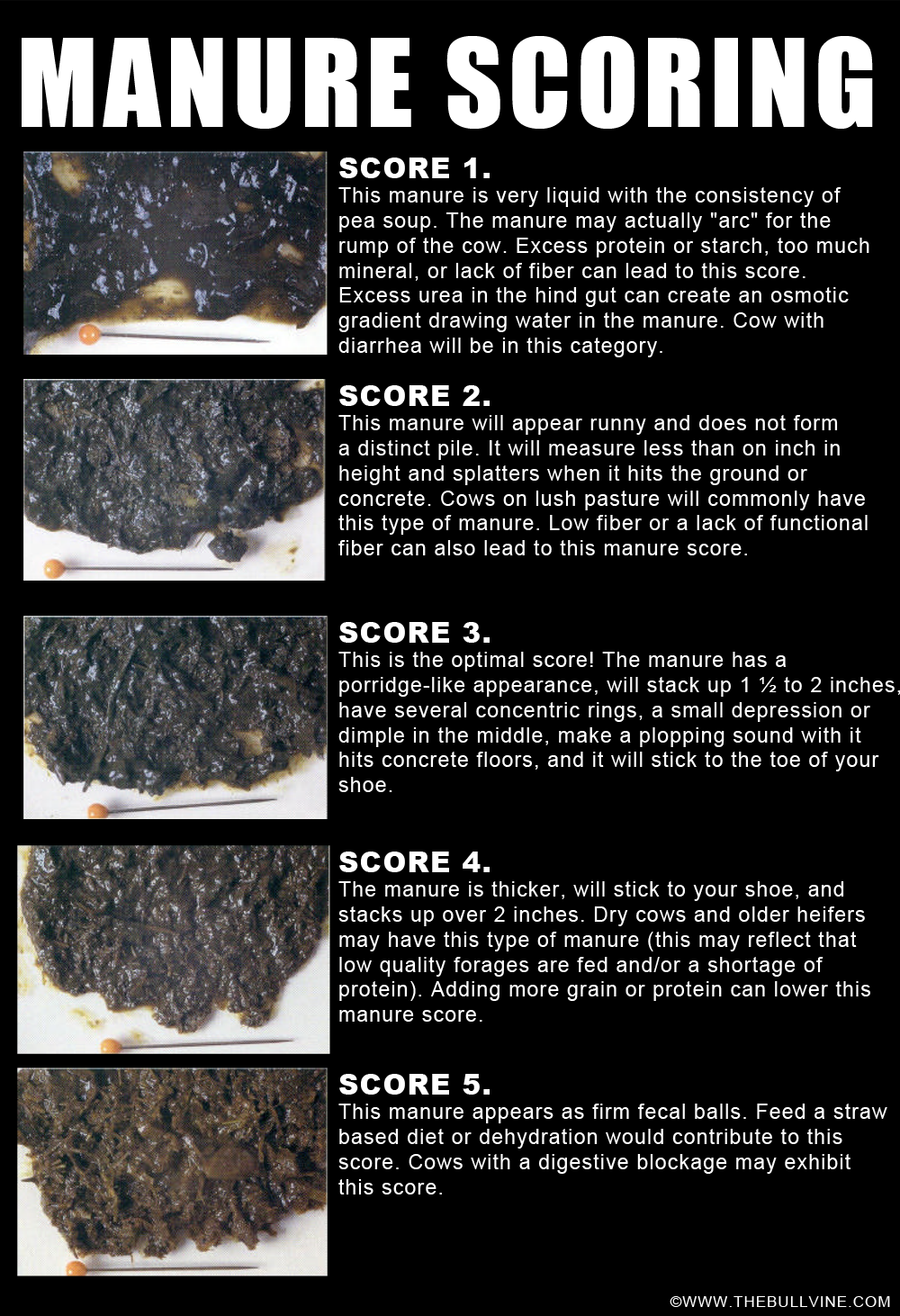Awareness is one of the best tools dairy managers can make use of. A daily barn or pasture walk with boots that don`t hesitate to poke into manure piles behind the cattle, can be a valuable signal of what`s happening with herd health and nutrition. No special equipment is required to make a speedy determination of the color, consistency and content of the manure being passed by a group of dairy cows.
The Three C’s: Consistency, Color and Content
If the cows share the same diet, their manure should share similar characteristics. In a 200-cow dairy, a walk-through that checks the manure of 15 to 20 cows should be able to provide enough observations to draw conclusions. The expectation is that less than five per cent will stand out as significantly different from the general herd. It is important to determine what is causing the difference.
Check Consistency First!
Feed drives production. Knowing the digestion status of the working cows is an important tool for making management decisions. What you see in the manure output, should be porridge-like and produce the dome-shaped 1 or 2 inch thick ‘plop’ that is the sign of healthy digestion. Feed type, the nutrient and fibre content, water quality and intake and passage rate all have an impact on the final product. Restricted water or protein produces firmer feces. Dehydration results in firm balls of manure. Seeing loose feces or diarrhea may indicate excessive protein intake or high levels of rumen degradable protein. Manure may be loose during periods of stress. Other cases of loose manure are far more serious and their actual causes seem to be harder to pinpoint. For example, sub-clinical acidosis (SARA) causes loose manure consistency to vary amongst herd members as well as other multiple changes over time for each suffering cow.
Color Paints a Management Checkpoint
Fecal color is influenced by feed type, bile concentration, and the passage rate of feedstuffs and digesta. Recognizing what is `normal` for the current type of diet being fed, sets up the opportunity to identify variations that could indicate a need for action. Typically, manure is dark green when cattle graze fresh forage and darkens to a brown-olive if animals receive a hay ration. When cows consume a typical TMR, feces are usually a yellow-olive color. This color results from the combination of grain and forage and will vary by the amount of grain and processing of that grain. If an animal experiences diarrhea, feces may change to a gray color. Animals undergoing medical treatment may excrete abnormal colored feces as a result of drugs that are administered. Dark or bloody manure may indicate hemorrhaging in the gastrointestinal tract from watery dysentery, mycotoxins, or coccidiosis. Light-green or yellowish manure combined with watery diarrhea can result from bacterial infections such as salmonella. Of course, any rapid change in colors signals that something is not right and immediate corrective action needs to be taken.
Content is Last but Not Least!
The third “c” to inspect is content. The contents of manure can provide dairy managers with information about how the dairy diet is working. Manure that is produced from cows fed a well-balanced nutritious ration (with adequate effective fibre) is very uniform. It contains digested feed particles with the majority of processed forage fibre no greater than 1/2 inch, and with little escaped grain.
Long forage particles or undigested grains are a sign that rumination has been challenged and the cause needs to be determined. It could be a problem with the animal or with the processing of the grain itself. Obviously these large particles in the manure mean that the nutrition in them has not been made available to the animals or to rumen microbes.
Mucus is another indicator to use as an alert. The presence of excessive amounts of mucus indicates chronic inflammation of or injury to gut tissue. Mucin casts also may be observed. These indicate damage to the large intestine, possibly caused by extensive hindgut fermentation and low pH. The mucin is produced by cells lining the intestine in an attempt to heal the affected area. As well manure that appears foamy or bubbly may indicate lactic acidosis or excessive hindgut fermentation resulting in gas production.
A Poop Picture Helps with Informed Decision Making
Manure scores 1 and 5 are not desirable and may reflect a health problem besides dietary limitations. Score 4 droppings may reflect a need to rebalance the ration. As cows progress through their lactation, manure score may also shift as outlined below.
- Fresh cows (score 2 to 2 ½)
- Early lactation cows (2 ½ to 3)
- Late lactation cows (3 to 3 ½)
- Far off dry cows (3 to 4)
- Close up dry cows (2 ½ to 3 ½)
Increasing the amount of degradable, soluble, or total protein; deceasing the amount or physical form of the fiber; increasing starch level, decreasing grain particle size (such as fine grinding or steam flaking), and consuming excess minerals (especially potassium and sodium) can cause manure scores to decline (for example from 3 to 2).
The color of manure is influenced by feed, amount of bile, and passage rate. Cows on pasture are dark green while hay based rations are more brown. High grain-based diets are more gray-like. Slower rates of passage causes the color to darken and become more ball-shaped with a shine on the surface due to mucus coating. Score 1 may be more pale due to more water and less bile content. Hemorrhage in the small intestine causes black and tar-like manure while bleeding in the rectum results in red to brown discoloration or streaks of red.
Physical Analysis
When it comes right down to manure evaluation, you have to get right down to it. After the 3 C’s inspection using eyes, boots and cow sense information, it’s time to look deeper. Collect at least five manure samples that appear to be representative of the group of animals. Mix the collected samples and place a pint-sized sample on a .05-.08- inch mesh sieve or in a strainer. Using a hose, wash a gentle, steady stream of water over the sieve, passing across the sample continuously until the water running from the bottom of the sieve is clear. Then gently use running water to roll or float the particles to one corner of the sieve and remove all material from the sieve.
Place the washed sample on a flat dark surface and examine it for the following:
- Long fiber particles — It is inevitable that some long forage particles will appear, but if most are greater than 0.5 inch there may be cause for concern. Poor digestion of forages may be due to the makeup of the fiber component of the diet (low quality forages) or to the ability of the animal to digest the forage being fed (poorly balanced rations).
- Grain particles — The small intestine is capable of digesting starch, allowing the cow to utilize this nutrient. However, the amount of starch digested is limited by the rate of digesta passage through the small intestine.
The Bullvine Bottom Line
It cannot be overemphasized how important it is to effectively manage herd health and nutrition. Every tool that informs that decision making process is valuable and manure evaluation is a valuable link in that chain of understanding. Don`t overlook the simplicity of a boots through the barn examination of your herd’s manure production. It’s not science but it gives the start to analyzing how your dairy diet is being consumed, digested and left behind.
Get original “Bullvine” content sent straight to your email inbox for free.





















Leave a Reply
You must be logged in to post a comment.